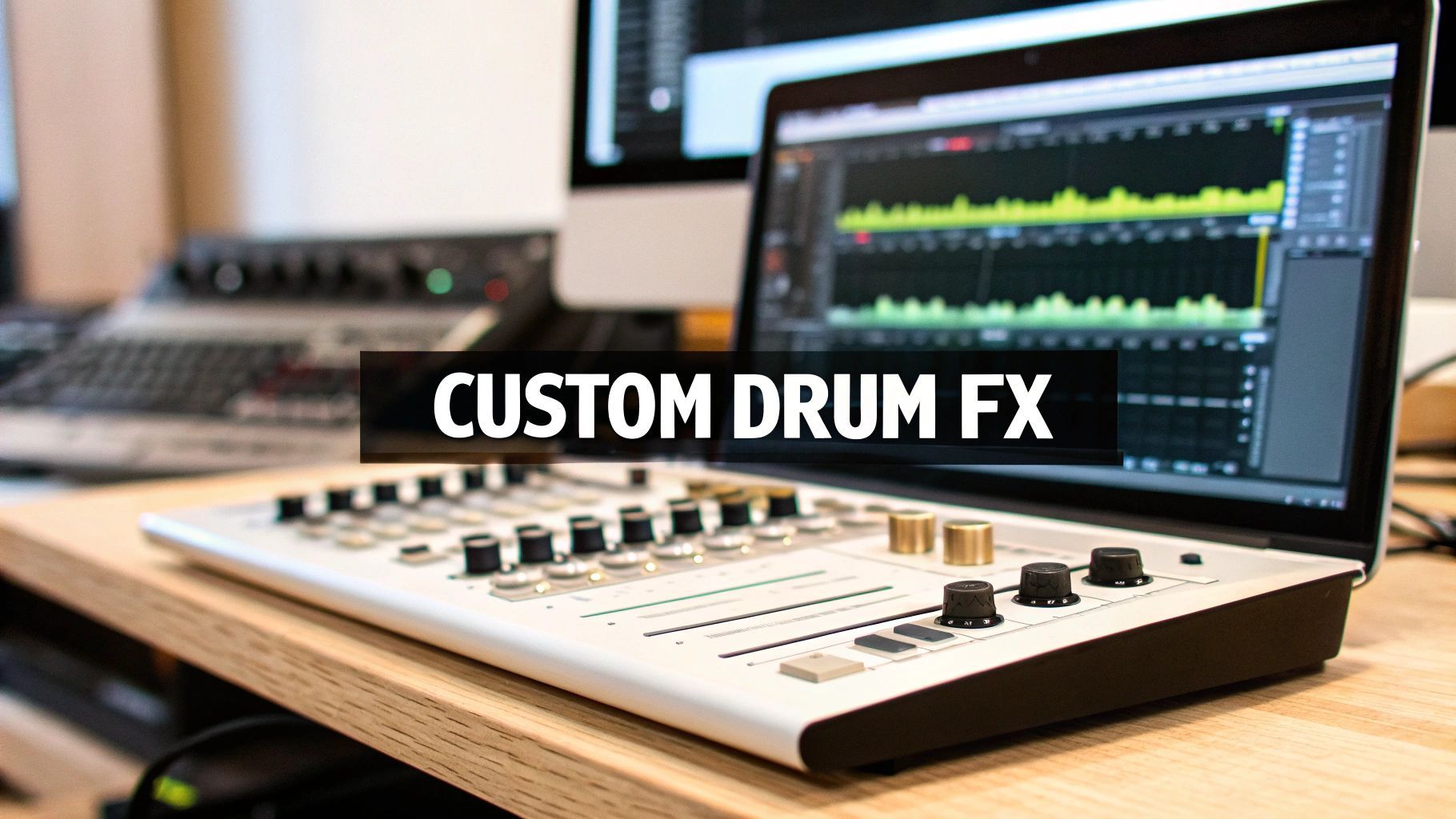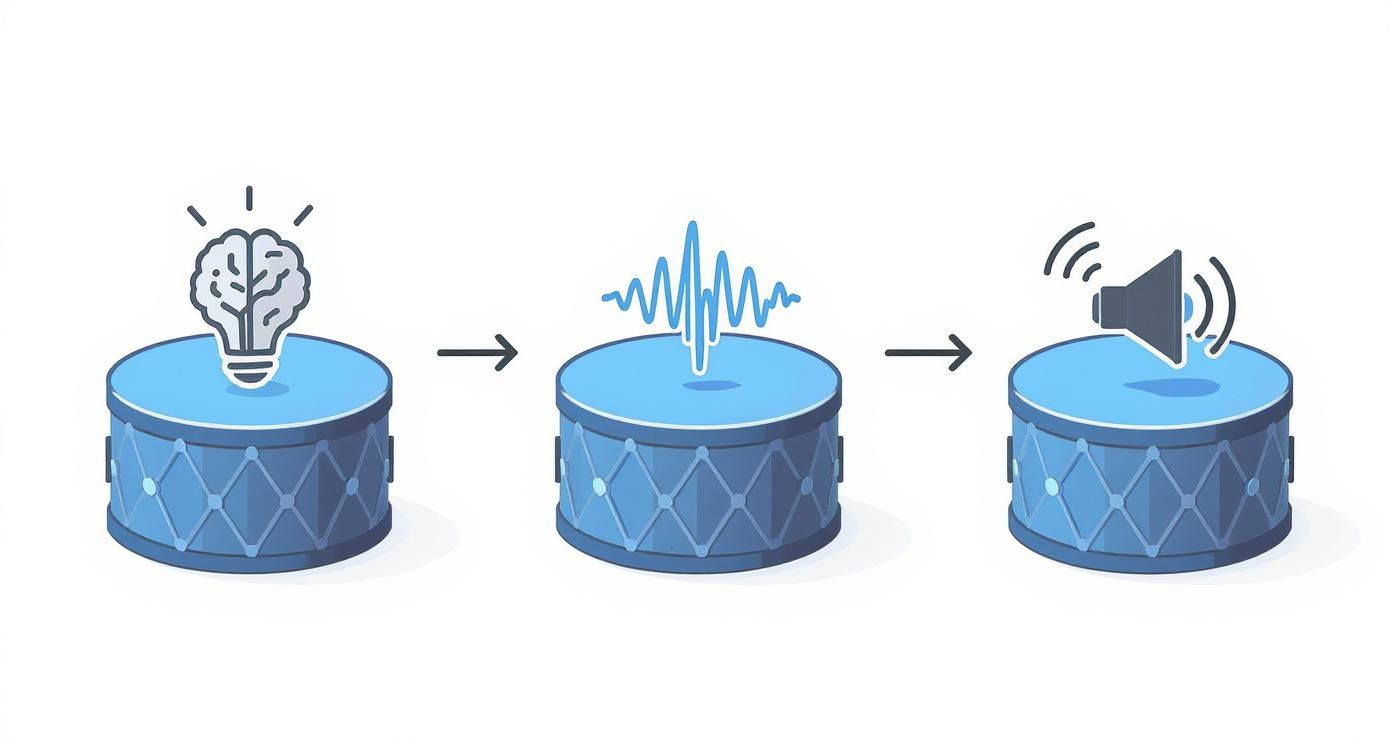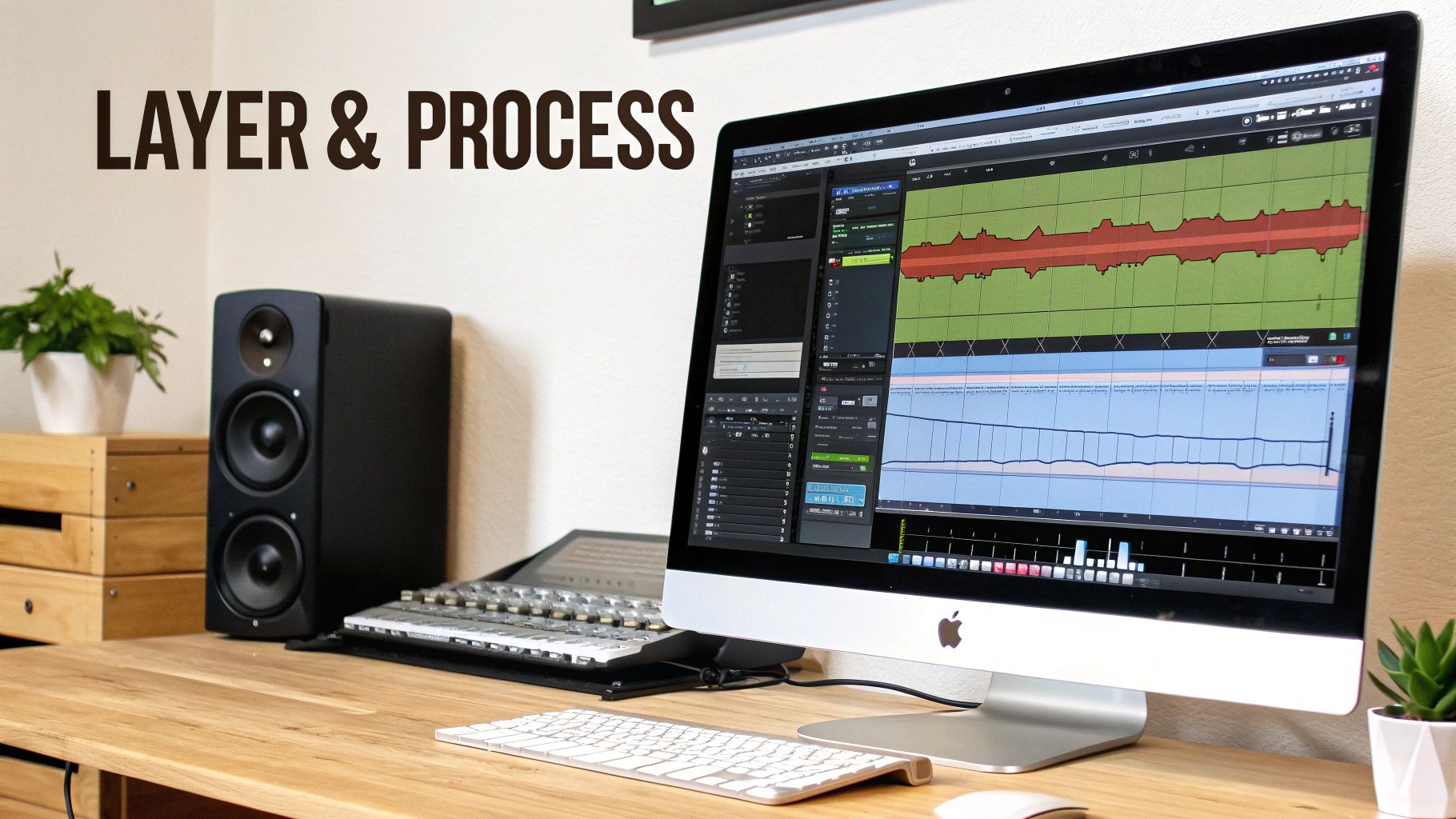
Let's face it, digging through generic sample packs is a soul-crushing part of the creative process. You know the exact sound you need—that perfect kick, snare, or cymbal—but you're stuck with "close enough." With AI tools like SFX Engine, that's changing. We can now generate completely unique, royalty-free percussive sounds just by describing them.
We're at a really exciting point in sound design. Crafting custom drum sounds isn't just a cool trick anymore; it's becoming essential for making projects like video games and film scores stand out. AI is completely flipping the script on how we build percussion, giving us a level of creative control that felt like science fiction just a few years ago.
Instead of hunting for a sound that almost works, you can design percussive elements that perfectly capture the mood of your project. You can literally generate the exact sound you're imagining.
When you rely on generic sound packs, you're always making a small compromise on your creative vision. AI generation puts you back in the driver's seat, letting you produce audio that is genuinely one-of-a-kind. This is a huge deal in crowded creative fields where distinctive audio can make or break a project.
Think about what this really means for your workflow:
The real magic of AI in sound design is its ability to turn an abstract idea into a concrete audio file, almost instantly. It doesn't just speed things up; it opens up sonic possibilities that would be a nightmare to create from scratch using traditional methods.
This infographic breaks down just how straightforward the process has become.

It really is that simple: from your initial idea, to the AI tool, to a finished sound you can use immediately.
The demand for high-quality, flexible audio is exploding. Just look at the electronic drum set market, a huge consumer of drum sound effects. It was valued at a massive USD 1.6 billion in 2023 and is expected to hit USD 3.8 billion by 2032. That growth is a clear signal that the industry is hungry for new and better sound solutions.
To get a better sense of how AI is shaking up the entire audio world, it's worth reading this guide on how to create music in the AI era. It provides a solid roadmap for turning a simple idea into a polished drum sound that makes your project sound incredible.
The real magic behind getting incredible AI-generated audio isn't in the engine itself—it’s in your prompts. This is your chance to be the director, to guide the AI to pull that exact drum sound you're hearing in your head out of the digital ether. If you’re just typing ‘snare drum’ and hoping for the best, you’re missing out on the engine’s true power.

The trick is to think like a sound designer describing a scene. You need to get descriptive. Combine textures, materials, actions, and even the environment to sculpt the sound before the AI even starts working. It's an back-and-forth process, and that's where the creative fun really begins.
A truly effective prompt gives the AI a complete picture to work with. I’ve found that the best ones usually weave together a few key elements.
kick drum, a hi-hat, or a rimshot? This is your anchor.wooden, metallic, glassy, gritty, smooth, or hollow. A metallic snare is a world away from a wooden snare.thump, crack, snap, tap, or stomp give the AI critical clues about the sound's dynamics and attack.cavernous, tight room, warehouse, outdoor field—tells the AI how to handle natural reverb and decay. It makes a huge difference.Once you start blending these elements, you're not just asking for a drum hit; you're creating a sonic event. If you want to dive deeper into the general principles of AI prompting (which apply across different creative tools), this Sora 2 Prompting guide is a fantastic resource.
Seeing is believing. Let's look at how adding a few descriptive words can completely transform a generic sound into something with real character and purpose.
The table below shows how a simple idea can evolve into a prompt that delivers a much more specific and interesting result.
From Basic Ideas to Detailed Prompts
| Sound Goal | Simple Prompt | Descriptive Prompt | Expected Result |
|---|---|---|---|
| A powerful kick | kick drum | deep, resonant kick drum with a slight metallic rattle, recorded in a large hall | A full-bodied kick with a complex tail and natural reverb. |
| A crisp snare | snare | tight, cracking snare hit with a short decay, sharp transient, gritty texture | A punchy, modern snare perfect for cutting through a dense mix. |
| A unique hi-hat | hi-hat | shuffling, metallic hi-hat made of thin aluminum, soft hit with a fast sizzle | A textured, lo-fi hi-hat with interesting metallic overtones. |
As you can see, the detail is everything. The descriptive prompts aren't just longer; they're telling a story about the sound.
The goal is iterative refinement. Your first prompt is rarely the final one. Treat each generation as a step closer to your ideal sound, tweaking adjectives and descriptors based on what the AI gives you.
Let's put this into a real-world scenario. Say you’re designing sounds for a sci-fi game. A simple prompt like laser gun will get you a sound, but it'll probably be generic.
Instead, try something like this: futuristic laser rifle shot, high-pitched energy charge followed by a heavy bass impact and a sizzling electrical crackle. Now you’re giving the AI a narrative to follow—a beginning, middle, and end. The result will be far more dynamic and memorable.
This is all about learning the language the AI understands best. The more specific you are, the more control you have. For a complete walkthrough of the entire process, from the first idea to the final export, check out our guide on how to create sounds with AI.
Getting a sound from a detailed prompt is a great start, but the real magic happens when you start playing with the AI's parameters. Think of your first generation as the raw clay; the parameters are your sculpting tools, letting you shape it into exactly what you need. This is where a decent sound becomes the perfect sound for your project.

Let’s go beyond just naming the sliders and dig into what they actually do. Understanding how things like punch, decay, reverb, and texture work together is the key to creating drum effects with purpose. This isn't about just wiggling knobs randomly; it’s about making deliberate choices to hit a specific sonic target.
And those sonic targets are more in demand than ever. The global drum sets market is actually projected to hit USD 4.6137 billion by 2033, which just shows how central percussion is to all kinds of modern media. You can dive deeper into these trends over at cognitivemarketresearch.com.
Once SFX Engine generates your drum sound, you’ll see a few core parameters ready for tweaking. Let's break down the most important ones and how to use them in the real world.
Punch: This is all about the initial hit of the sound—the transient. Cranking up the punch makes a kick drum feel aggressive and sharp, perfect for cutting through a busy mix in a video game. Dialing it back softens the attack, giving a snare a more subtle, washy feel.
Decay: This is simply how long the sound rings out. A really short decay on a hi-hat gives you that tight, snappy rhythm you hear in a lot of electronic tracks. On the other hand, a long decay on a snare can create an epic, booming sound that's ideal for a dramatic film trailer.
Texture: This parameter is your secret weapon for adding character. It can introduce subtle grit, a bit of sizzle, or even a metallic rattle. Adding just a little texture to a super-clean cymbal can make it sound like it was recorded in a real room, giving it a more organic and less sterile vibe.
Reverb: Reverb is what gives your sound a sense of space. Maxing it out can place your drum in a massive cathedral, making it feel huge and distant. Killing the reverb completely gives you a dry, intimate sound that feels like it's right next to the listener's ear—great for a podcast stinger or an ASMR-style effect.
So, how does this work in practice? Let's say you generated a basic kick using the prompt "deep kick drum thump," but it’s not quite fitting your project.
Scenario 1: EDM Track Kick You need a kick that hits hard but gets out of the way of the bassline.
Scenario 2: Cinematic Trailer Hit Here, the goal is a kick that sounds massive, like it's shaking the entire theater.
Remember, tweaking these parameters is a back-and-forth process. Make a small change, listen carefully, and then decide what to do next. If it sounds right for your project, it is right. Trust your ears.
By working through these controls methodically, you can take one single generated sound and morph it to fit dozens of different needs. This is how you build a custom drum sound effects library that's truly versatile.
Okay, so you've generated some solid drum sounds with SFX Engine. That's a great start. But if you want to create sounds that are truly unique and pack a professional punch, the real magic happens when you start layering and processing.
A single AI-generated sound is just the beginning. The secret is to think like a sound designer—building a finished sound from multiple, carefully chosen pieces.

This is how you get from a decent "thump" to a visceral, unforgettable impact. You're not just finding a sound; you're building one.
Layering is the cornerstone of modern sound design. The concept is simple: combine different sonic elements to create a single sound that's bigger and better than its individual parts. For a powerful kick drum, for instance, you're usually blending a sharp attack, a beefy body, and a deep, rumbling tail.
Let's walk through a practical example. Imagine you need a kick drum for the primary weapon in a sci-fi game.
sharp metallic click, quick transient, no tail. This gives you that initial "snap" that defines the hit.soft wooden thump, mid-range body, punchy will generate the meaty part of the sound that gives it weight.deep sub-bass sine wave, low rumble, long decay to create that foundation you feel more than you hear.Once you drag these three sounds into your DAW, you have total creative control. You can tweak the volume of each layer to perfectly balance the attack, body, and weight. It's this level of detail that professionals obsess over. The demand for these high-quality, custom sounds is only growing; the global electronic drums market, a huge consumer of drum sound effects, is expected to hit USD 2.11 billion by 2032. This explosive growth shows just how much producers and developers are hunting for unique percussion.
With your layers balanced, it's time for the final polish. Post-processing is what "glues" the individual pieces together into a single, cohesive sound. You don't need a massive plugin library—just a few key tools.
The key is subtlety. Don't obliterate your sound with processing. Small, tasteful adjustments to EQ, compression, and saturation are what elevate a good sound into a great one. The goal is to enhance, not to overpower.
By combining thoughtful layering with a bit of careful processing, you can turn AI-generated sounds into truly professional assets. This is the exact workflow I use when building out a custom game sound effects library that makes a project stand out from the crowd.
Alright, you’ve spent the time crafting the perfect percussive hit. Now what? A killer sound effect is only as good as its implementation, so let's get it out of the sound design sandbox and into your actual project—be it a game, film, or podcast.
This is where the magic really happens, bridging the gap between a cool sound and a memorable experience.
First things first, you need to export your sound, and the file format you choose matters more than you might think. It’s a trade-off between quality and file size, and for professional work, quality almost always wins.
For just about any serious application, WAV is the only way to go. It’s a lossless format, which is just a technical way of saying it keeps 100% of the original audio data. No compression, no shortcuts. This is absolutely essential for preserving the crisp transient of a snare or the deep rumble of a kick, especially since it will likely be mixed and processed later.
MP3s are a different beast entirely. They're "lossy," meaning they shrink file sizes by throwing away audio information your ears supposedly won't miss. While that's fine for your workout playlist, that same compression can neuter the impact of a carefully designed drum hit.
Here's my rule of thumb: Always export your master files as WAVs. You can always make a smaller MP3 from a high-quality WAV if needed, but you can never get back the quality once it's lost to compression.
If you want a more detailed look at file management, we've put together a guide on how to download sounds from SFX Engine that covers best practices for keeping your library organized.
With your high-quality WAV file ready, it's time to drop it into your project. How you use it will, of course, depend entirely on the context.
Here are a few scenarios I run into all the time:
And finally, a quick but important note on licensing. Every sound you generate with SFX Engine includes a full commercial license. That means you can use your creations in any project, from indie games to major films, without ever having to worry about royalties or legal headaches. Now go make something awesome.
As more and more creators start using AI to craft custom audio, the same questions tend to bubble up. Let's tackle some of the most common concerns I hear, from legal rights to getting that perfect organic feel for your drum sound effects.
This is about more than just the tech; it's about making it fit into your real-world workflow. Knowing the answers lets you create with confidence.
This is the big one: who owns the sound, and can you use it commercially? The short answer is yes, but the devil is in the details—it all comes down to the service you're using. When you work with a solid platform like SFX Engine, every single sound you generate comes with a full commercial license. That means it’s 100% royalty-free for any project you can dream up.
I always tell people to quickly scan the terms of service for any tool they use. Even though the AI is creating a completely new sound file from your prompt, what makes it truly unique is your combination of descriptive words, parameter tweaks, and post-production layering. That creative process makes the final result yours.
The real value isn't just in the sound itself, but in the commercial freedom that comes with it. Knowing you can use your custom creations in a monetized YouTube video, an indie game, or a major film without legal worries is a massive advantage for any creator.
One of the most common challenges is getting AI percussion to feel less robotic and more alive. The trick is to steer the AI toward natural imperfection right from the start.
Think about describing the materials and the tiny flaws that make real-world sounds so interesting.
wood, skin, brushed, or uneven in your prompts.faint rattle or slight buzz.Another pro-level move is to use post-processing to add that analog warmth we all love. Just a touch of tape saturation or a subtle tube emulation plugin can instantly breathe life into your drum sound effects, making them feel less sterile. It’s these small, intentional details that convince the listener's ear that what they're hearing is real.
Ready to move beyond generic sample packs and start creating your own signature percussion? Get started with SFX Engine today and generate unique, royalty-free drum sounds in seconds. Visit the SFX Engine website to begin for free.